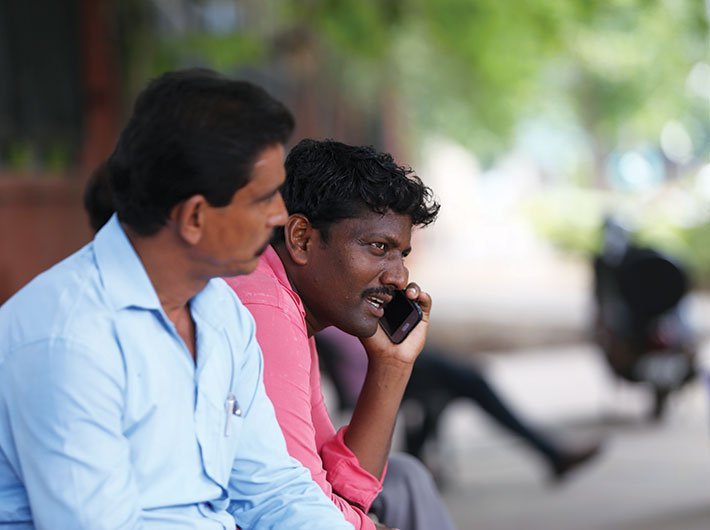How much time do Indians spend talking on phone? It is on average 761 minutes per month, according to a new report from the Telecom Regulatory Authority of India (TRAI).
The telecom regulator released its report, titled ‘The Indian Telecom Services Performance Indicators: July-September, 2020’, on Thursday. This report provides a broad perspective of the telecom services in India and presents the key parameters and growth trends of the telecom services as well as cable TV, DTH and radio broadcasting services in India for the period between July 1 to September 30 last year, compiled mainly on the basis of information furnished by the service providers.
The ubiquitous mobile phone is now much more than a device to make and receive calls, but as far its basic function is concerned, the report notes, “On all India average, the overall Minutes of Usage (MOU) per subscriber per month for wireless service increased by 2.37% from 744 in QE Jun-20 to 761 in QE Sep-20.”
‘MOU per subscriber per month’ is calculated by dividing total minutes of usage (incoming and outgoing) by average number of subscribers.
Among other highlights of the report from its executive summary:
* The number of telephone subscribers in India increased from 1,160.52 million at the end of Jun 20 to 1,168.66 million at the end of Sep-20, registering a growth of 0.70% over the previous quarter. This reflects Year-On-Year (Y-O-Y) decline rate of 2.22% over the same quarter of the last year. The overall tele-density in India also increased from 85.85% as in QE Jun-20 to 86.22% as in QE Sep-20.
* Telephone subscribers in urban areas increased from 636.83 million at the end of Jun-20 to 644.26 million at the end of Sep-20 and urban tele-density also increased from 137.35% to 138.25% during the same period.
* Rural telephone subscribers increased from 523.69 million at the end of Jun-20 to 524.39 million at the end of Sep-20 however, rural teledensity remained same, i.e., 58.96%, as it was during last quarter June, 2020.
* Out of the total subscription, the share of rural subscription decreased from 45.13% at the end of Jun-20 to 44.87% at the end of Sep-20. With a net increase of 7.88 million subscribers during the quarter, the total wireless subscriber base increased from 1,140.71 million at the end of Jun-20 to 1, 148.58 million at the end of Sep-20, registering a growth rate of 0.69% over the previous quarter. However, wireless subscriptions declined on Y-O-Y basis at the rate of 2.14% during the year.
* Wireless Tele-density increased from 84.38% at the end of Jun-20 to 84.74% at the end of Sep-20 with quarterly growth rate of 0.43%. Wireline subscribers increased from 19.81 million at the end of Jun-20 to 20.08 million at the end of Sep-20 with a quarterly growth rate of 1.34%, however, on Y-O-Y basis, wireline subscriptions declined by6.58% at the end of QE Sep-20. Wireline Tele-density increased from 1.47% at the end of Jun-20 to 1.48% at the end of Sep-20.
* Total number of Internet subscribers increased from 749.07 million at the end of Jun-20 to 776.45 million at the end of Sep-20, registering a growth of 3.66%. Out of the internet subscribers, the number of Wired Internet subscribers are 24.36 million and the number of Wireless Internet subscribers are 752.09 million.
* Monthly Average Revenue per User (ARPU) for wireless service increased by 7.49%, from 00.12 in QE Jun-20 to 06.87 in QE Sep20. On Y-O-Y basis, monthly ARPU for wireless service increased by30.24% in this quarter.
* A total of 911 private satellite TV channels have been permitted by the Ministry of Information and Broadcasting (MIB) for uplinking only/ downlinking only/ both uplinking and downlinking, as on 30th Sep, 2020.
* As per the reporting done by broadcasters in pursuance of the Tariff Order (Broadcasting & Cable), dated 3rd March 2017, as amended, there are 327 pay channels as on 30th September 2020, which include 231 SD (standard definition) pay TV channels and 96 HD (high definition) Pay TV channels.
* Since its introduction in the year 2003, DTH (direct-to-home) service has displayed phenomenal growth. During QE 30th September 2020, there were 4 pay DTH service providers in the country. Pay DTH has attained total active subscriber base of around 70.70 million in QE 30th September 2020. This is in addition the subscribers of DTH Free Dish (free DTH services of Doordarshan).
* Apart from the radio stations operated by All India Radio, the public broadcaster, as on 30th September 2020, there are 367 operational private FM Radio stations in 105 cities with operational 31 Private FM Radio broadcasters same as previous quarter.
The full summary is available here: https://static.pib.gov.in/WriteReadData/userfiles/Press%20Release%20English%202021.pdf
